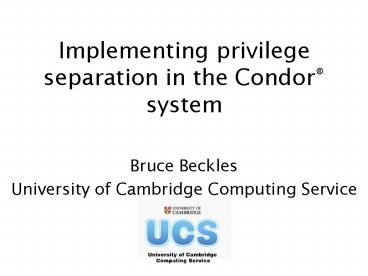Implementing privilege separation in the Condor PowerPoint PPT Presentation
1 / 13
Title: Implementing privilege separation in the Condor
1
Implementing privilege separation in the Condor
system
- Bruce Beckles
- University of Cambridge Computing Service
2
What is privilege separation?
- Isolation of those parts of the code that run at
different privilege levels
3
The principle of least privilege
- Code only ever runs at the minimum level of
privilege required for its current task
4
How do we do this?
- User context switching
root context switching daemon
Condor daemons
- GNU userv allows one process to invoke another
(in either the same or a different user context)
in a secure fashion when only limited trust
exists between them (see http//www.gnu.org/softwa
re/userv/).
5
Who does what?
- Execute nodes
- Change ownership of any file (CAP_CHOWN
capability) - Switch to any user context (CAP_SETUID
capability) - Send signals to any process (CAP_KILL capability)
- Submit nodes
- Switch to any user context (CAP_SETUID
capability) - Send signals to any process (CAP_KILL capability)
- Central manager
- No privilege switching required (unless GSI
authentication is being used, in which case need
to be able to switch to any user context
(CAP_SETUID capability)) - (Note that if you have the ability to switch to
any user context you effectively have the ability
to send signals to any process.)
6
Details Central manager
- Unless using GSI authentication, Condor daemons
dont need to run as root, so - dont run them as root(!)
- If using GSI
- Flawed security paradigm, so
- waste of time trying to make the system more
secure
7
Details Execute node
- No Condor daemon or process runs as root
- Condor passes job to our wrapper script
- Our script installs a signal handler to intercept
Condors signals to the job - Our script changes the ownership of the jobs
files (via userv) as necessary at beginning and
end of job - Our script fork()s a userv process which runs
the job in a different (also non-privileged) user
context - On receipt of a signal from Condor, our script
calls userv to send the signal to the job - userv uses pipes to pass the jobs standard
output and standard error back to our script (and
so to Condor) - A cron job (using Condors STARTD_CRON mechanism)
runs once a minute to make sure that if there is
no job executing then there are no processes
running in our dedicated Condor job user context
8
What does this gain us?
- If there is a vulnerability in Condor then the
entire machine is not compromised as a result. - We do not have any Condor processes, whose real
user ID is root, listening to the network. - Much greater control over the jobs execution
environment could run the job chrootd if
desired. - Our wrapper script can examine the job and make
more sophisticated decisions about whether or not
to run it (restrict to local executables, etc.) - We now have a hook for executing arbitrary
tasks on job completion, a feature ordinary
Condor lacks. - If a Condor job leaves behind any processes
running after job completion they will be killed
normally, Condor only does this properly if
specially configured (EXECUTE_LOGIN_IS_DEDICATED).
9
What do we lose?
- Can no longer suspend jobs (cannot catch SIGSTOP)
- We now need to handle passing the job environment
variables, setting resource limits and scheduling
priority, etc., which Condor would normally
handle - Condor can no longer correctly distinguish
between the load Condor processes and Condor jobs
are putting on the machine, and the load
generated by other processes - Information returned by Condor about the jobs
CPU utilization, etc. is incorrect - Cannot work with GSI authentication
- Does not yet work with Condors Standard universe
(although this may not be difficult to fix) - Adds of the order of 5 seconds to job execution
time
10
Details Submit node
- If not using strong authentication (Kerberos,
etc.), can use a similar technique - If using strong authentication then this wont
work - condor_shadow processes need to run as the
submitting user, but - machine credentials need to not be accessible to
ordinary users - Damn!
- So
11
Fully privilege separated architecture (1)
- Requires extensive changes to Condor code
- No Condor daemon or process runs as root
- User context switching daemon provides services
to Condor components that would otherwise need a
higher level of privilege - Long running Condor daemons that communicate with
the network are privilege separated
OpenBSD-style - Split into two components that run in different
user contexts one that exclusively handles
network communication, one that does everything
else - Network component chroot()d to somewhere safe
- Components communicate via some form of IPC
mechanism (e.g. Unix domain sockets) - Allows authentication credentials to be protected
but still used for authentication (network
component acts as a relay between other component
and the remote daemon)
12
Fully privilege separated architecture (2)
- For short running Condor daemons
(condor_starter, condor_shadow, etc) - Typically instantiated by a long running daemon
- Parent daemon could set up secure network channel
which child then inherits - This gives the child a session key
- When session key is due to expire (or if
re-negotiation of secure channel is required) - Use session key to authenticate to parent
daemon - Now act as a relay for passing authentication
messages between remote daemon and parent daemon
to re-negotiate secure channel
13
Future work
- Architecture described on the last two slides is
just a proposal - Details may (will!) change as design evolves
- Working with Condor Team to implement some form
of privilege separation, probably for the Condor
6.9 development series

